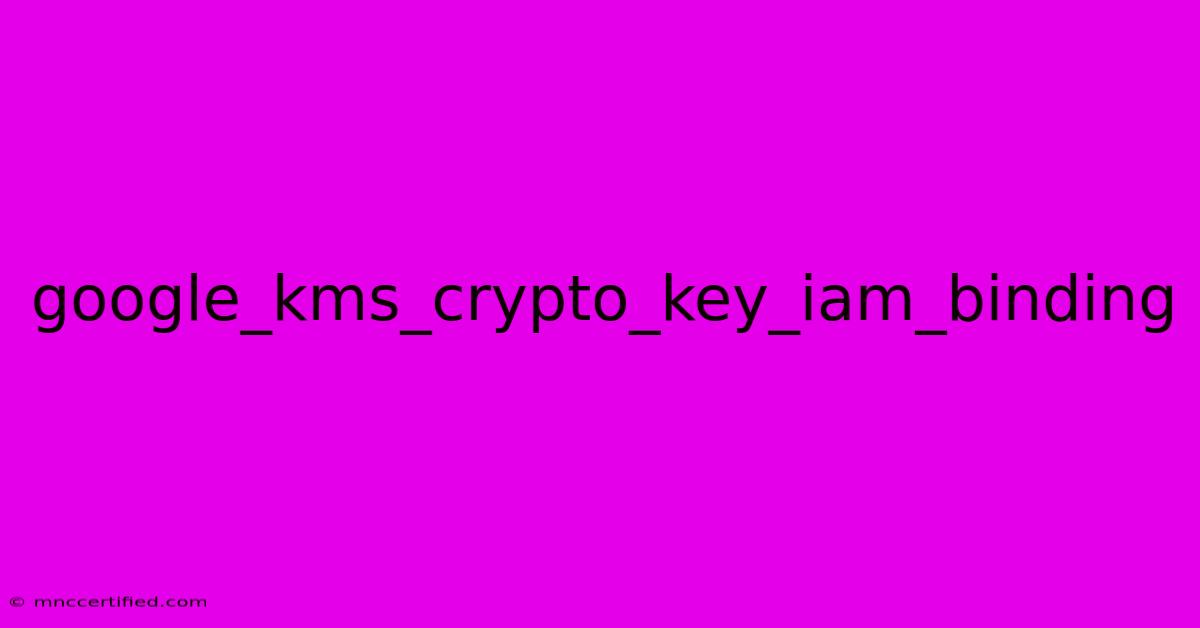Google_kms_crypto_key_iam_binding

Table of Contents
Understanding Google Cloud KMS CryptoKey IAM Bindings: A Comprehensive Guide
Google Cloud Key Management Service (KMS) is a crucial component for securing your cloud infrastructure. At its core lies the concept of CryptoKeys – the cryptographic keys used to encrypt and decrypt your sensitive data. Managing access to these keys is paramount, and that's where IAM bindings come into play. This guide will delve deep into google_kms_crypto_key_iam_binding, explaining its function, practical applications, and best practices for secure implementation.
What is google_kms_crypto_key_iam_binding?
google_kms_crypto_key_iam_binding refers to the configuration within Google Cloud's Identity and Access Management (IAM) system that governs access to a specific CryptoKey. It defines which users, service accounts, or groups have specific permissions to perform actions on that key. This is a fundamental aspect of securing your data, ensuring only authorized entities can access and utilize your encryption keys.
Instead of directly manipulating keys, which is a significant security risk, IAM provides a robust mechanism for managing access. The google_kms_crypto_key_iam_binding resource allows granular control, letting you specify precisely what actions each entity is permitted to perform.
Key Components of the Binding:
-
members: This field specifies the identities granted access. These identities can be individual users, service accounts (crucial for automated processes), or groups of users. The format typically includesuser:[email protected],serviceAccount:[email protected], orgroup:[email protected]. -
role: This defines the permissions granted to the specified members. Examples includeroles/cloudkms.cryptoKeyEncrypterDecrypter(allowing encryption and decryption),roles/cloudkms.cryptoKeyVerifier(allowing verification), androles/cloudkms.cryptoKeyAdmin(providing full administrative control – use with extreme caution). -
cryptoKey: This uniquely identifies the CryptoKey to which the binding applies. This is a fully qualified resource name.
Practical Applications and Use Cases
Understanding the practical implications of google_kms_crypto_key_iam_binding is crucial for effective security management. Let's explore several use cases:
1. Secure Application Deployment:
When deploying applications that require encryption at rest or in transit, you might create a service account specifically for encryption/decryption operations. A google_kms_crypto_key_iam_binding would then grant this service account the roles/cloudkms.cryptoKeyEncrypterDecrypter role, limiting its access solely to the necessary cryptographic functions.
2. Data Segmentation and Least Privilege:
For enhanced security, implement the principle of least privilege. Instead of granting broad permissions, assign only the minimum necessary access to each identity. This approach minimizes the impact of potential breaches. For instance, a database administrator might only need the roles/cloudkms.cryptoKeyDecrypter role to access encrypted backups, not full administrative control.
3. Auditing and Compliance:
IAM logs meticulously record all access attempts and modifications to CryptoKeys. This detailed auditing trail is essential for compliance with industry regulations (like HIPAA or GDPR) and for internal security audits. Analyzing these logs helps identify suspicious activity and maintain a robust security posture.
4. Multi-Region Deployments:
When deploying across multiple Google Cloud regions, ensure your IAM bindings are correctly configured for each region and CryptoKey. Maintaining consistent access control across your geographically distributed infrastructure is vital.
Best Practices for Secure Implementation
-
Least Privilege: Always follow the principle of least privilege. Grant only the minimum necessary access to each identity.
-
Regular Audits: Regularly review and audit your IAM bindings to identify any unnecessary or overly permissive configurations.
-
Service Accounts: Utilize service accounts for automated processes, avoiding the use of individual user accounts whenever possible.
-
Rotation of Credentials: Regularly rotate your service account keys and periodically review and update your IAM bindings.
-
Centralized Management: Implement a centralized system for managing IAM policies, preventing configuration drift and ensuring consistency.
-
Monitoring and Alerting: Set up monitoring and alerting to detect suspicious activity related to your CryptoKeys and IAM bindings.
Conclusion
Effective management of google_kms_crypto_key_iam_binding is non-negotiable for robust security within Google Cloud. By understanding the intricacies of IAM bindings and adhering to best practices, you can significantly strengthen your organization's security posture and protect your sensitive data. Remember to prioritize least privilege, regular auditing, and meticulous monitoring to ensure the long-term security of your cryptographic keys.

Thank you for visiting our website wich cover about Google_kms_crypto_key_iam_binding. We hope the information provided has been useful to you. Feel free to contact us if you have any questions or need further assistance. See you next time and dont miss to bookmark.
Featured Posts
-
I M A Celebritys Gk Barry Bio Facts
Nov 18, 2024
-
Marvin Odooms Coronation Street Connection
Nov 18, 2024
-
Coleen Rooneys Jungle Test
Nov 18, 2024
-
Aspinalls Message To Jones After Ufc 309
Nov 18, 2024
-
Seattle Seahawks Week 11 Game Outlook
Nov 18, 2024